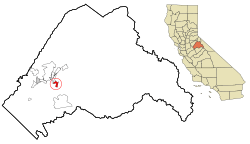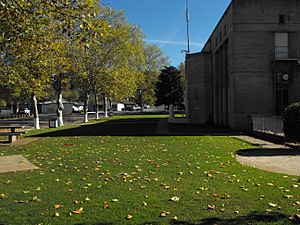Tuolumne City, California facts for kids
Quick facts for kids
Tuolumne City, California
Tuolumne
|
|
|---|---|

West Side Memorial Park, Tuolumne
|
|

Location in Tuolumne County and the state of California
|
|
| Country | |
| State | |
| County | Tuolumne |
| Area | |
| • Total | 2.362 sq mi (6.118 km2) |
| • Land | 2.332 sq mi (6.040 km2) |
| • Water | 0.030 sq mi (0.078 km2) 1.27% |
| Elevation | 2,569 ft (783 m) |
| Population
(2020)
|
|
| • Total | 1,798 |
| • Density | 761.2/sq mi (293.89/km2) |
| Time zone | UTC-8 (Pacific (PST)) |
| • Summer (DST) | UTC-7 (PDT) |
| ZIP code |
95379
|
| Area code(s) | 209 |
| FIPS code | 06-80763 |
| GNIS feature IDs | 1867064, 2409362 |
Tuolumne City is a small community in Tuolumne County, California. It is not an official city but is known as an unincorporated town. This means it's a community that doesn't have its own local government separate from the county. The area is also part of a census-designated place (CDP) called Tuolumne, which is a special area defined by the U.S. Census Bureau for collecting population data. In 2020, about 1,798 people lived in the CDP.
Contents
Exploring Tuolumne City's Past
Tuolumne City has a rich history, especially known for its logging operations. For many years, cutting down trees and processing timber was a major activity here. You can still find parts of old logging railroads in the area today.
Logging Railroads and Theme Park Dreams
In the 1970s, a man named Herbert Reichhold had a big idea. He wanted to turn Tuolumne into a "Railroad Theme Park." He planned to use old narrow-gauge steam trains from the logging days. He even started buying properties in the town for his project. However, he stopped his plans after his wife passed away.
Later in the 1970s, Glen Bell, who founded the famous Taco Bell restaurants, opened his own train attraction. It was called the "Westside and Cherry Valley Railroad." This tourist train ran for about 5 miles from the old lumber mill into the mountains. It used the same tracks and some of the old locomotives from the logging company. This fun attraction ran for several years but closed in the mid-1980s.

Community Life and Facilities
Tuolumne City has several important services and facilities for its residents. These include schools, communication services, and community centers.
Connecting with the World
For a long time, Tuolumne had its own special telephone company, the Tuolumne Telephone Company. This was different from most of Tuolumne County. Now, this company is part of a larger one called Frontier Communications.
Local Schools and Learning Centers
The community is home to a few schools. Summerville Elementary serves students from kindergarten to 8th grade. Mother Lode Christian School offers classes for all grades, from kindergarten to 12th grade. Older students attend Summerville Union High School for grades 9-12. Summerville High also hosts the Connections Arts School for students in grades 7-12, focusing on arts education.
Economic Changes and Growth
Tuolumne City faced tough times when the West Side Lumber Company mill closed. This logging company was a big part of the town's economy. For many years, the community worked hard to find new ways to support itself.
A major boost came from the Tuolumne Band of Me-Wuk Indians. This is a federally recognized tribe that has its main office in Tuolumne. They own and operate the Black Oak Casino nearby. The money from the casino has helped the community grow. Recent improvements include a new medical clinic and a new library. The Tuolumne City Memorial Museum on Carter Street has also been updated.
Merging Communities
Tuolumne City was once two separate towns: "Summersville" in the south and "Carter" in the north. Over time, they joined together to form the single town we know today. A new local council has been created to help guide the town's revival and future.

Where is Tuolumne City?
Tuolumne City is located in California at these coordinates: 37°57′42″N 120°14′13″W / 37.96167°N 120.23694°W.
The United States Census Bureau reports that the entire census-designated place (CDP) covers about 2.4 square miles (6.1 square kilometers). Most of this area, about 2.3 square miles (6.0 square kilometers), is land. A small part, about 0.03 square miles (0.078 square kilometers), is water.
Who Lives in Tuolumne City?
In 2010, the population of Tuolumne was 1,779 people. Most residents were White, with smaller populations of African American, Native American, Asian, and Pacific Islander individuals. About 11.6% of the population identified as Hispanic or Latino.
The median age in 2010 was 41.4 years. This means half the people were younger than 41.4, and half were older. About 22.3% of the population was under 18 years old.
Famous People from Tuolumne City
- Bobby Adams: A professional baseball player who played in Major League Baseball.
- Lord Buckley: Born Richard Myrle Buckley, he was a famous performer known for his unique style of comedy. He also worked as a logger in Tuolumne.
California Historical Landmark
Summersville, which is now part of Tuolumne, is recognized as a California Historical Landmark. This landmark, number 407, tells us about the area's early history.
It explains that the first non-Native American settlers, the Franklin Summers family, arrived in 1854. They built a log cabin nearby. This area was a central spot for the East Belt Placer Gold Rush from 1856 to 1857. In 1858, James Blakely found the first quartz gold vein here, naming it 'Eureka.' This mine helped the town of Summersville grow. The town was later called Carters before finally becoming Tuolumne. Other gold rush towns like Long Gulch and Cherokee were also nearby.
See also
 In Spanish: Tuolumne City para niños
In Spanish: Tuolumne City para niños



